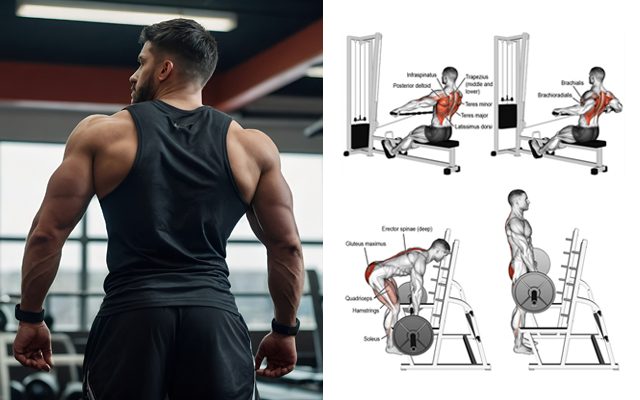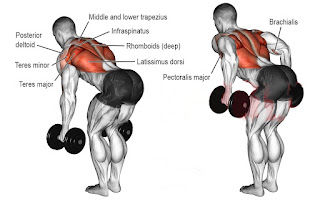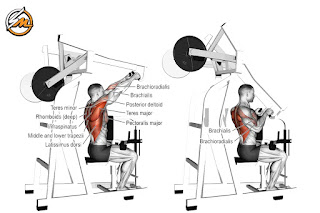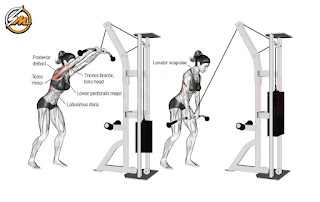Building strong back muscles requires a combination of exercises targeting different back muscle groups and proper form to maximize results and prevent injury.
There are numerous benefits to training your back muscles, beyond just aesthetics. Here's a breakdown of some key advantages:
Improved Posture: Strong back muscles help pull your shoulders back and maintain a neutral spine, leading to better posture. This not only looks good but also reduces strain on your joints and improves your overall balance.
Reduced Back Pain: Weak back muscles are a recipe for back pain. Strengthening your back helps support your spine and reduces the risk of injuries.
Increased Strength and Power: Back muscles are involved in many everyday activities like lifting, pulling, and bending. Training your back translates to greater overall strength and power, making daily tasks easier.
Improved Athletic Performance: A strong back is crucial for athletes in various sports. It enhances core stability, throwing power, and overall performance.
Better Breathing: Good posture allows your lungs to expand more fully, leading to better oxygen intake and improved lung function.
Enhanced Core Stability: Back exercises often engage your core muscles, which provide stability throughout your body. This translates to better balance and coordination.
Increased Bone Density: Weight-bearing back exercises can help strengthen your bones, reducing the risk of osteoporosis later in life.
Improved Mental Well-being: Exercise in general releases endorphins, which have mood-boosting effects. Training your back can contribute to a more positive outlook and reduced stress.
Boosted Metabolism: Building muscle mass slightly increases your resting metabolic rate, meaning you burn more calories even at rest.
Overall Improved Physique: A strong back contributes to a more balanced and defined physique.
Incorporating back exercises into your workout routine is a smart investment in your overall health and well-being.
6 Back Exercises for Building Muscle and Strength
1- Wide-Grip Lat Pulldown
Setup:
Sit on the lat pulldown machine and adjust the knee pad to secure your legs.
Grab the wide bar attachment with an overhand grip (palms facing forward). Your hands should be positioned wider than shoulder-width apart.
Movement:
Lean back slightly with your chest out and core engaged. This is your starting position.
Exhale as you pull the bar down towards your upper chest. Focus on squeezing your shoulder blades together and bringing your elbows down and back. Imagine pulling with your lats, not your biceps.
Hold the squeeze at the bottom for a second, feeling the tension in your lats.
Inhale as you slowly return the bar to the starting position, fully extending your arms.
Key Points:
Maintain good posture throughout the movement. Avoid arching your back or leaning forward excessively.
Focus on using your lats to pull the weight, not your arms.
Don't swing or use momentum to lift the weight.
Control the weight throughout the entire movement, both on the pull down and the return.
Avoid pulling the bar behind your neck, as this can put strain on your shoulders.
Variations:
You can also perform wide-grip lat pulldowns with a neutral grip (palms facing each other).
Safety:
Choose a weight that allows you to maintain proper form throughout the exercise.
If you feel any pain in your shoulders or lower back, stop the exercise and consult a trainer or doctor.
2- Bent Over DB Rows
Bent-over dumbbell rows are a fantastic exercise to build a strong back! Here's a breakdown of how to perform them with proper form:
Equipment:
A pair of dumbbells with a weight challenging for you (choose a weight that allows controlled movement for all repetitions).
Starting Position:
Stand with your feet shoulder-width apart and knees slightly bent. Hold a dumbbell in each hand with a neutral grip (palms facing each other). Your back should be flat, core engaged, and shoulders pulled back and down.
Hinge at the Hips:
Bend forward at your hips, hinging from a point behind your hips, until your torso is roughly parallel to the floor (or slightly above). Maintain a flat back throughout the movement; avoid rounding your lower back.
The Row:
Keeping your elbows close to your body and back straight, row the dumbbells up by driving your elbows back and squeezing your shoulder blades together. Pull the dumbbells towards your sides until your elbows reach (or slightly surpass) your torso midline.
Controlled Lowering:
Slowly lower the dumbbells back down to the starting position with control. Focus on retracting your shoulder blades and maintaining a flat back throughout the movement.
Repeat:
Complete your desired number of repetitions before switching to the other arm (single-arm rows) or performing sets with both arms simultaneously (double-arm rows).
Here are some additional tips for proper form:
Maintain a neutral spine throughout the exercise.
Don't use momentum to swing the weights.
Focus on squeezing your shoulder blades together at the top of the movement.
Breathe out as you row the weights up, and inhale as you lower them.
Choose a weight that allows you to maintain proper form throughout all repetitions.
Variations:
You can perform bent-over rows with a barbell instead of dumbbells.
You can adjust the torso angle depending on your flexibility and comfort level.
If you're a beginner, it's recommended to consult with a certified trainer to ensure proper form and avoid injury.
3- Machine High Row
Setup:
Adjust the Machine: Sit on the seat and adjust the leg pad so your thighs are parallel to the ground and your feet flat. Lean in and set your chest against the chest pad.
Grip the Handles: Grab the handles with an overhand grip.
Starting Position:
Extend your arms fully forward, with a slight arch in your lower back and shoulders pulled back and down.
The Row:
Keeping your core engaged and back straight, pull the handles towards your torso, squeezing your shoulder blades together. Focus on using your back muscles to pull the weight, not your biceps. Imagine pulling your elbows back behind you, rather than just bending your arms.
Squeeze and Hold:
At the top of the movement, pause for a second to contract your back muscles.
Return Slowly:
Slowly lower the handles back to the starting position, feeling a stretch in your lats (back muscles) as your arms straighten.
Tips:
Maintain proper form throughout the exercise. Don't use momentum to swing the weight.
Breathe out as you pull the weight towards you, and inhale as you return to the starting position.
Choose a weight that allows you to perform 8-12 repetitions with good form.
You can also perform this exercise with a neutral grip (palms facing each other) or an underhand grip (palms facing up) to target different muscles in your back.
4- Seated PF Cable Rows
Seated Cable Rows, also sometimes called Seated Low Rows, target your middle and upper back muscles. Here's how to do them with proper form:
Equipment:
Low pulley cable machine with a V-bar attachment (preferred) or handle
Set Up:
Adjust the weight stack to a challenging weight. Sit on the machine with your knees bent and feet flat on the footplate.
Grip:
Grasp the V-bar handle with a neutral grip (palms facing each other) or handle with an overhand grip (palms facing down). Keep your hands shoulder-width apart.
Starting Position:
Lean forward slightly from your hips, maintaining a natural arch in your lower back and core engaged. Your arms should be extended straight down towards the weight stack.
The Row:
Initiate the movement by squeezing your shoulder blades together and back. Then, pull the handle towards your lower abdomen, keeping your elbows close to your sides throughout the movement. Focus on using your back muscles to pull the weight, not your biceps.
Squeeze:
As you pull the handle in, squeeze your back muscles at the end of the movement. Hold for a second.
Return:
Slowly release the weight back to the starting position by extending your arms, but don't completely lock out your elbows.
Tips:
Maintain a controlled movement throughout the exercise. Don't swing the weight or use momentum.
Keep your core engaged to stabilize your spine.
Breathe out as you pull the handle in and inhale as you return to the starting position.
You can adjust your grip width to target different parts of your back muscles. A narrower grip will emphasize your lats, while a wider grip will work more of your upper back.
5- Rope Cable Pullovers
Set up:
Adjust the cable pulley to the highest setting.
Attach the rope to the carabiner on the pulley.
Grip and Position:
Grasp the rope with a neutral grip (palms facing each other).
Step back from the machine a few feet to allow for full arm extension.
Bend at your hips and knees slightly, maintaining a flat back with a natural arch.
Engage your core to stabilize your torso throughout the exercise.
Movement:
Keeping a slight bend in your elbows, slowly lower the rope down towards your thighs.
Focus on initiating the movement with your lats (back muscles) rather than your arms.
Imagine squeezing your shoulder blades together as you pull the rope down.
Lower the rope until you feel a stretch in your lats.
Control and Squeeze:
Avoid using momentum. Maintain control throughout the movement.
At the bottom of the movement, hold the squeeze for a second to maximize lat engagement.
Return:
Slowly reverse the movement, bringing the rope back up to shoulder height.
Focus on feeling your lats working to pull the weight back up.
Repeat:
Complete your desired number of repetitions (typically 8-12 reps).
Tips:
Maintain a slight bend in your elbows throughout the movement.
Don't arch your back excessively. Keep a natural arch in your lower back.
Focus on controlled movement and squeezing your lats for maximum benefit.
Choose a weight that allows you to maintain proper form throughout the reps.
Variations:
You can perform this exercise with a wide grip (thumbs further apart on the rope) to target the upper lats, or a narrow grip (thumbs closer together) to target the lower lats.
Safety:
If you feel any pain in your lower back, stop the exercise and consult a doctor or physical therapist.
Start with a lighter weight and gradually increase as you get stronger.
Don't use momentum to swing the weight.
6- Barbell Rack Deadlifts
Equipment:
Power Rack
Barbell
Weight plates (appropriate for your fitness level)
Optional: Wrist straps (for heavier weights)
Setup:
Adjust the safety bars in the power rack to slightly below knee height when standing on the platform.
Load the barbell with desired weight plates.
Approach the bar and position yourself under it with your shins nearly touching the bar.
Form:
Squat down and grab the barbell with an overhand grip, slightly wider than shoulder-width apart. Your arms should be straight down.
Engage your core by taking a deep breath into your stomach and brace yourself.
Maintain a neutral spine with a slight arch in your lower back, chest up, and shoulders back and down.
Stand tall by driving through your heels and hips, keeping the bar close to your shins as you lift. Imagine pushing the floor away with your feet.
Movement:
Pull the barbell up in a straight line, keeping your core engaged and back straight throughout the movement. Don't round your back or let your arms bend.
Lock out your hips and knees when you reach the top position, squeezing your glutes. Briefly hold this position.
Lower the barbell in a controlled manner back down to the starting position on the safety bars. Don't bounce the weight off the bars at the bottom.
Tips:
Start with a light weight to focus on proper form before increasing weight.
Maintain a controlled tempo throughout the movement, both lifting and lowering the weight.
Don't jerk the weight up. Use your leg drive and core to initiate the lift.
If you feel any pain in your lower back, stop the exercise and consult a trainer or doctor.













0 Comments